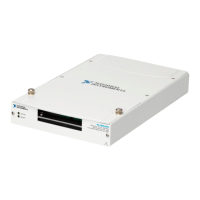Chapter 4 Analog Input
M Series User Manual 4-4 ni.com
Analog Input Lowpass Filter
A lowpass filter attenuates signals with frequencies above the cutoff
frequency while passing, with minimal attenuation, signals below the
cutoff frequency. The cutoff frequency is defined as the frequency at which
the output amplitude has decreased by 3 dB. Lowpass filters attenuate noise
and reduce aliasing of signals beyond the Nyquist frequency. For example,
if the signal of interest does not have frequency components beyond
40 kHz, then using a filter with a cutoff frequency at 40 kHz will attenuate
noise beyond the cutoff that is not of interest. The cutoff frequency of the
lowpass filter is also called the small signal bandwidth. The specifications
document for your DAQ device lists the small signal bandwidth.
On some devices, the filter cutoff is fixed. On other devices, this filter is
programmable and can be enabled for a lower frequency. For example, the
NI 628x devices have a programmable filter with a cutoff frequency of
40 kHz that can be enabled. If the programmable filter is not enabled, the
cutoff frequency is fixed at 750 kHz. If the cutoff is programmable, choose
the lower cutoff to reduce measurement noise. However, a filter with a
lower cutoff frequency increases the settling time of your device, as shown
in the specifications, which reduces its maximum conversion rate.
Therefore, you may have to reduce the rate of your AI Convert and AI
Sample Clocks. If that reduced sample rate is too slow for your application,
select the higher cutoff frequency.
Add additional filters to AI signals using external accessories, as described
in the Cables and Accessories section of Chapter 2, DAQ System Overview.
Table 4-3. Input Ranges for NI 628x
Input Range
Nominal Resolution Assuming
5% Over Range
–10 V to 10 V 80.1 μV
–5 V to 5 V 40.1 μV
–2 V to 2 V 16.0 μV
–1 V to 1 V 8.01 μV
–500 mV to 500 mV 4.01 μV
–200 mV to 200 mV 1.60 μV
–100 mV to 100 mV 0.80 μV

